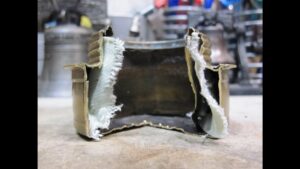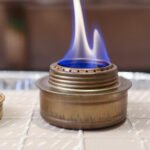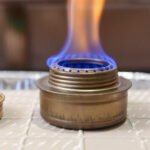The Gold Standard
I think that the Trangia B25 spirit burner is instantly recognisable to anyone who has ever camped and cooked using a spirit burner. Since its initial production in 1951, it has become the de facto gold standard burner. Most new burners look either identical to or at least very much like the original. There’s a good reason for this – the Trangia is hard to improve upon.
Construction
 The burner has no moving parts. Built of solid brass, it is robust and unadorned. It burns any one of several alcohol spirits as fuel. The deceptively simple exterior disguises some innovative technology.
The burner has no moving parts. Built of solid brass, it is robust and unadorned. It burns any one of several alcohol spirits as fuel. The deceptively simple exterior disguises some innovative technology.
Liquid alcohol doesn’t burn; the vapours do. The hotter the alcohol is, the more it evaporates, and that, in turn, generates even more heat. The majority of the heat doesn’t come from the big central opening but from the small holes in the top section of the burner. The walls of the burner are double, with a cotton wick stuffed between the inner and outer walls for much of the height. This allows the liquid to wick up and then evaporate below the vents. When lit, the flame only comes from the central opening, and the vents don’t start working, or “blooming”, until the system heats up. Once evaporation builds enough pressure to push the volatile gas out of the vents, it ignites, producing a clean flame and heat. This is why these types of stoves get really hot – it isn’t a design flaw, as many suppose, but a design feature!
Use


After ignition, it takes a while for the burner to get hot enough so that the gas comes out the holes and ignites. This is called the “bloom”, and before that happens, the stove is not particularly efficient. Spirits are not particularly energy-dense compared to mineral fuels such as diesel, petroleum, and gasoline. But they are readily available, inexpensive, and adequate for heating.
These small burners are unfortunately quite susceptible to wind, and even a slight draft can significantly disrupt efficient heating. But with a windshield, they can heat a meal, and it is perhaps the most reliable heating method available. While gas canisters and pressurised petroleum-burning heaters are much more powerful and can heat meals much faster, they are not maintenance-free like the Trangia.


